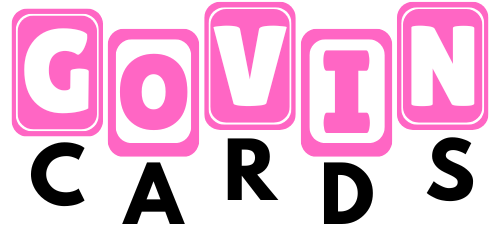Your seven-year-old plops down at the piano bench and opens their lesson book. The page looks like someone scattered random dots and squiggles all over lined paper. They point at the treble clef and ask, “What’s that weird curly thing?” You realize they’re staring at music notation the same way you might look at ancient hieroglyphics in a museum.
But here’s what’s funny: that same kid can sing along perfectly to every song on the radio. They tap rhythms on the dinner table. They know when music gets loud or soft, fast or slow. They already understand music. They just can’t read the written version yet.
These Music Symbols Flashcards bridge that gap. Important symbols that show up in every piano book, violin lesson, and elementary school music class. We’re not talking about advanced music theory that makes adults’ heads spin. Just the basic symbols every kid needs to recognize so sheet music starts making sense instead of looking like a foreign language.
Walk into any music classroom and you’ll see these symbols everywhere. Treble clefs decorate bulletin boards. Time signatures sit at the beginning of every song in the songbooks. Note values appear in rhythm exercises. When kids learn what these symbols mean, music notation transforms from confusing scratches into readable instructions for making beautiful sounds.
The Symbols Kids Actually See
These Music Symbols Flashcards focus on what children encounter in real music lessons, not obscure symbols they might never use. Every symbol connects to sounds and experiences kids already have from listening to music every day. You can also check emotions flashcards for kids to give them a wide learning option.
1.The Staff and Its Guardians:
- Treble clef shows up first in most music lessons because it covers the higher notes that sound comfortable to young ears. Piano students use it for right-hand melodies. Violin, flute, and trumpet players live here almost exclusively. That curly symbol tells musicians that the second line represents the note G.
- Bass clef looks like a backwards treble clef with two dots. Piano students need this for left-hand parts that provide the deep, rumbling foundation under melodies. Cello, trombone, and bassoon players call this home. The two dots surround the line that represents F.
2. Note Values That Tell Time Stories:
- Whole note sits on the staff like a hollow oval with no stem. It lasts four full beats, which feels like counting very slowly: “one… two… three… four…” Kids can relate this to holding their breath as long as possible.
- Half note looks like a whole note with a stem attached. It gets two beats, creating that steady walking pace you hear in many folk songs and hymns. Children naturally feel this rhythm when they march or walk to music.
- Quarter note appears as a filled-in circle with a stem. This gets one beat and forms the backbone of most popular music. When kids clap along to their favorite songs, they’re usually clapping quarter notes without realizing it.
- Eighth note looks like a quarter note with a little flag attached to its stem. It gets half a beat and creates those quick, running rhythms that make music feel energetic and alive.
3. Silence Has Its Own Symbols:
- Whole rest hangs from the fourth line like a small black rectangle. It means “be quiet for four beats,” which teaches kids that pauses are just as important as sounds in music.
- Half rest sits on the third line like an upside-down whole rest. Two beats of silence that creates breathing room between musical phrases.
- Quarter rest looks like a squiggly line that resembles a stylized lightning bolt. One beat of silence that adds bounce and rhythm to music.
- Eighth rest appears as a diagonal line with a flag, similar to its note counterpart. Half a beat of silence that creates those tiny gaps that keep music from sounding mechanical.
4. Time Signatures Set the Rules:
- 4/4 time signature shows two number 4s stacked on top of each other at the beginning of music. The top number says “count four beats per measure.” The bottom number says “quarter notes get one beat each.” Most pop songs, rock music, and marches use this pattern.
- 3/4 time signature shows a 3 over a 4, creating that swaying waltz feeling. Three beats per measure with quarter notes getting one beat each. “Happy Birthday,” carousel music, and classical waltzes all use this lilting rhythm.
- Common time uses a big “C” symbol as shorthand for 4/4 time. Musicians see this and immediately know to count “1-2-3-4” in each measure.
5. Pitch-Changing Symbols:
- Sharp symbol looks like a small tic-tac-toe grid and raises any note by a half-step. When kids hear music that sounds bright or tense, they’re often hearing sharped notes.
- Flat symbol resembles a lowercase “b” and lowers notes by a half-step. This creates warmer, sometimes sadder sounds that add emotional depth to music.
- Natural symbol looks like a small rectangular box with lines and cancels previous sharps or flats, bringing notes back to their original pitch.
6. Volume Control Markings:
- Piano marking uses a lowercase “p” to tell musicians “play softly.” This creates gentle, intimate moments in music.
- Mezzo piano combines “mp” for “moderately soft.” Not whisper-quiet, but still gentle and controlled.
- Mezzo forte shows “mf” meaning “moderately loud.” This gives music presence without overwhelming other sounds.
- Forte uses a lowercase “f” for “play loudly.” This creates those powerful, dramatic moments that make audiences sit up and pay attention.
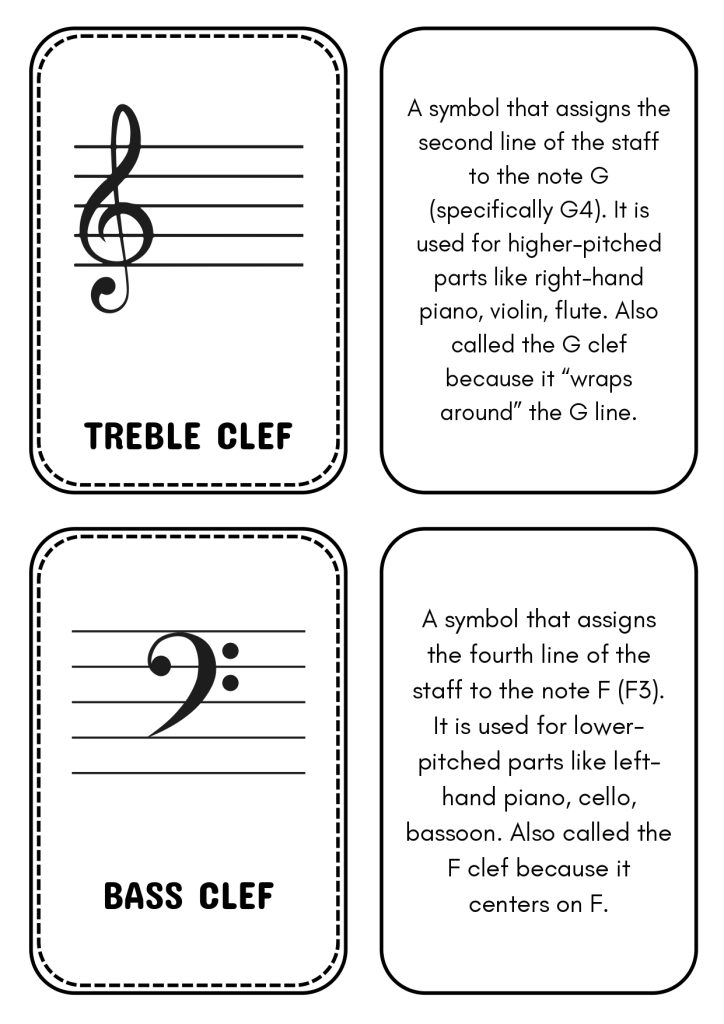

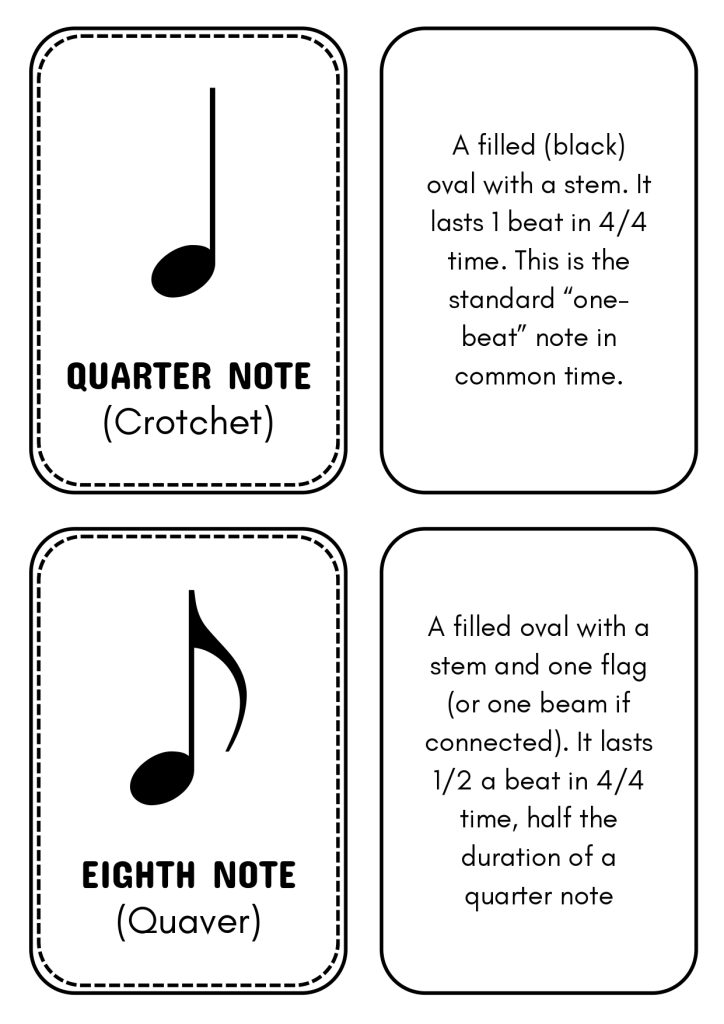
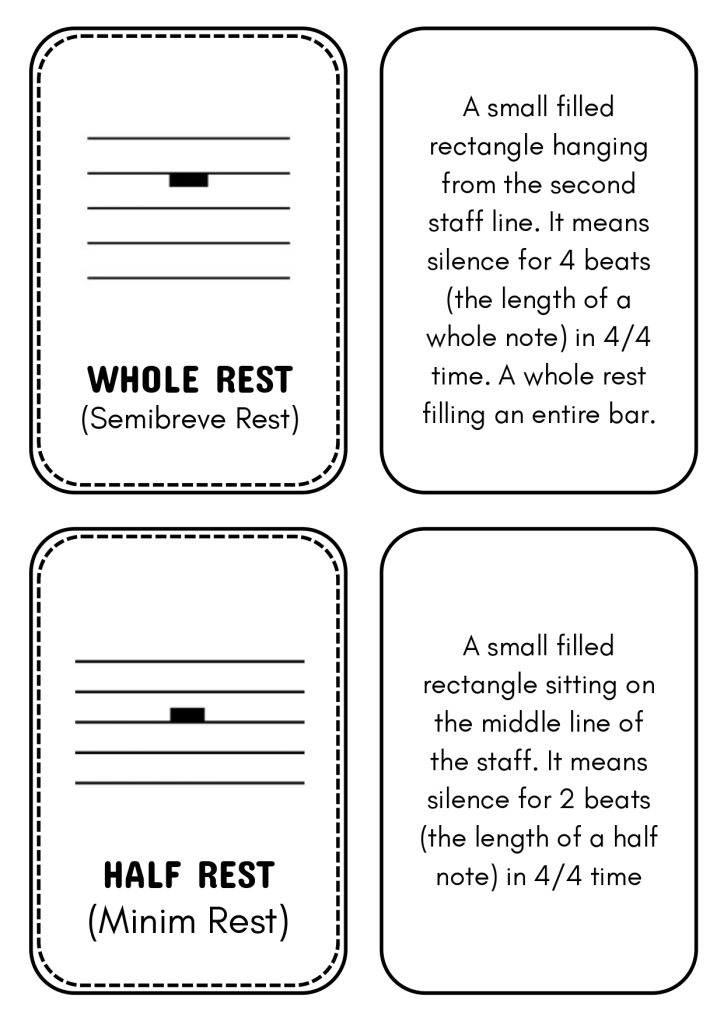
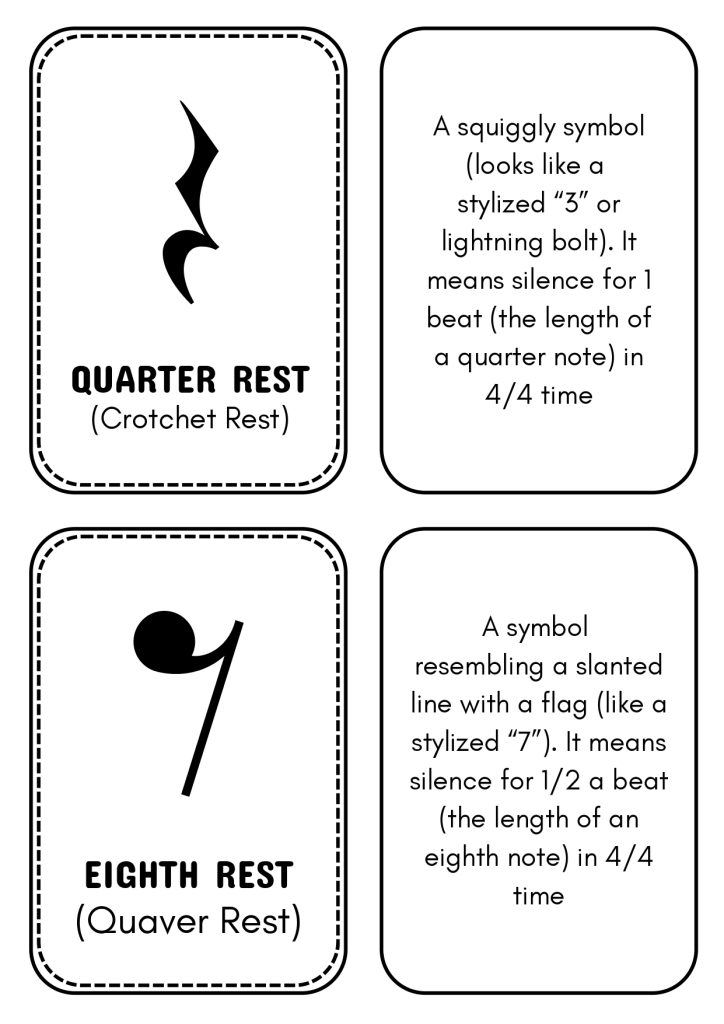
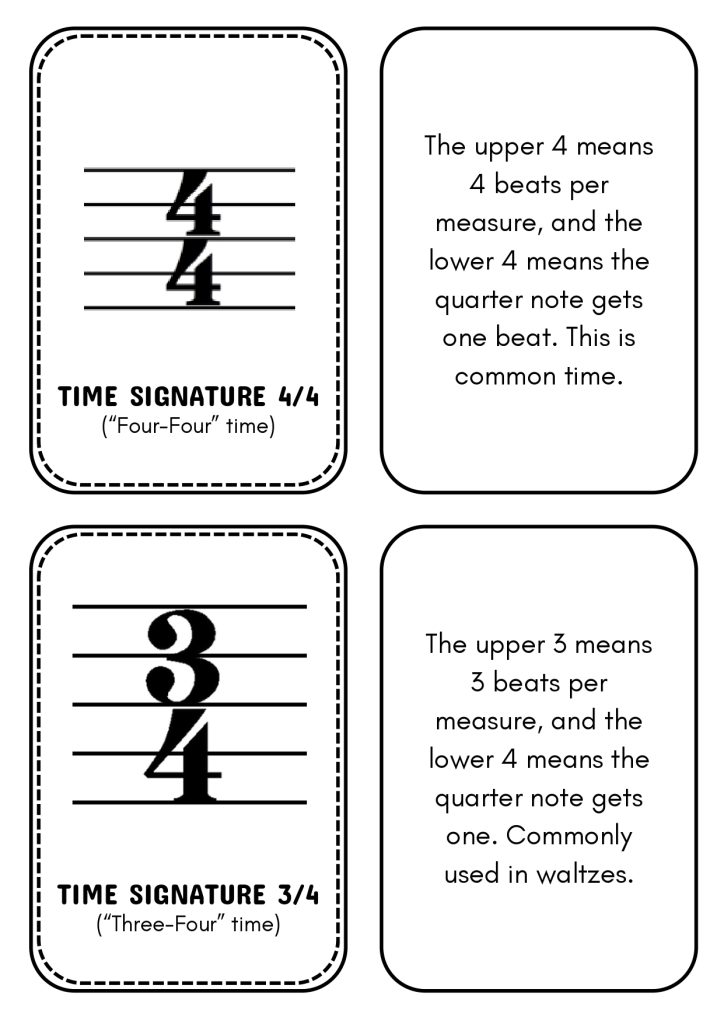

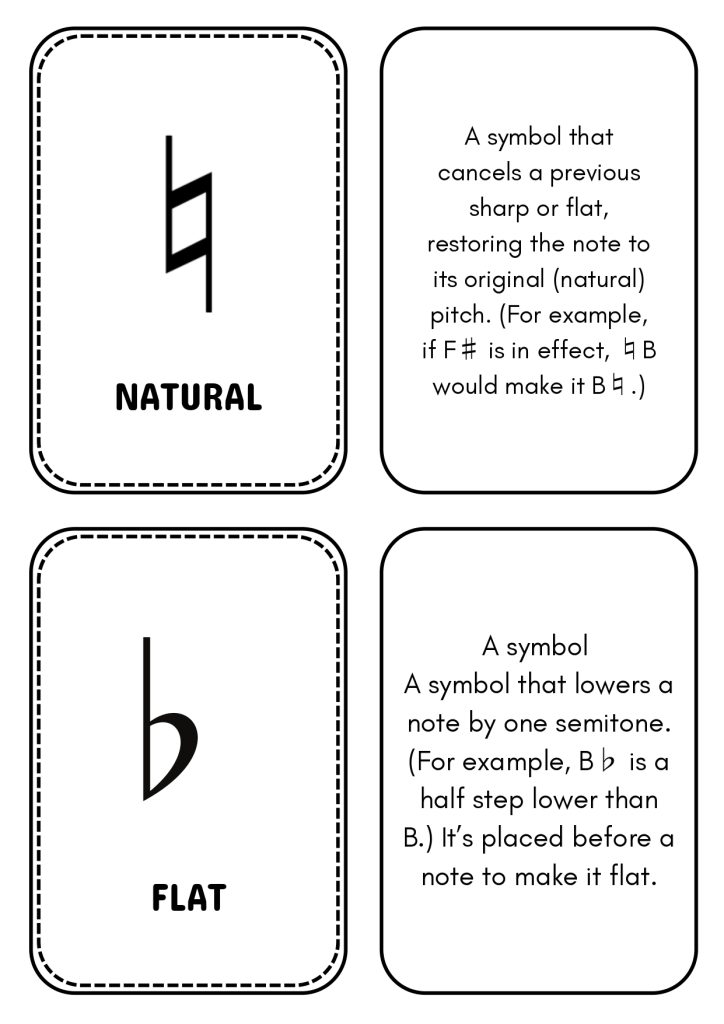
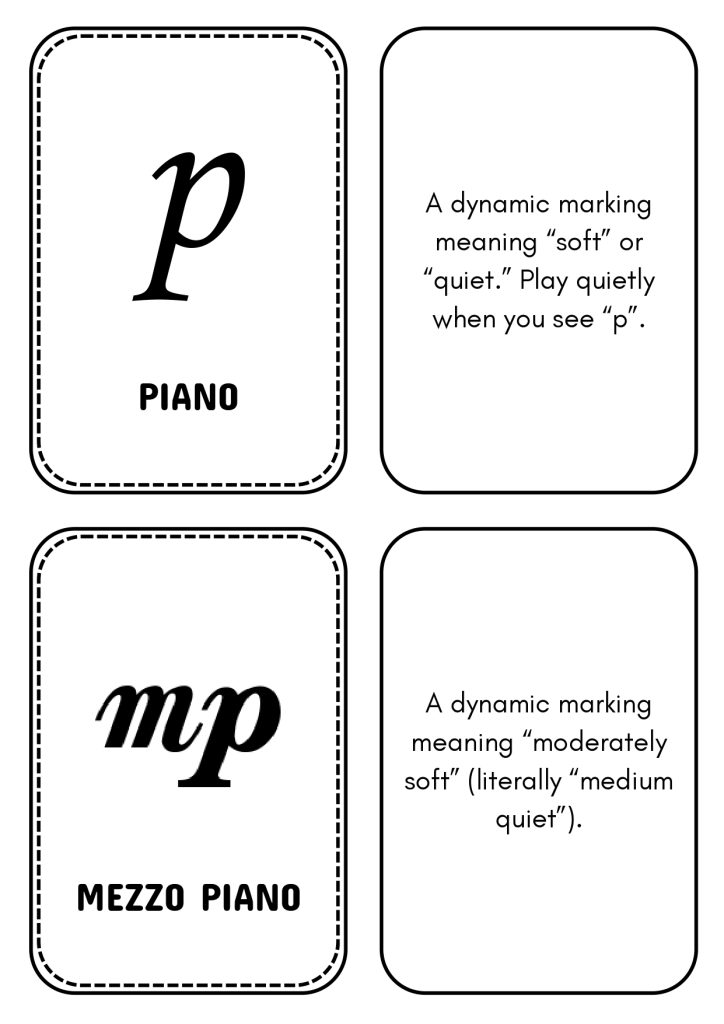
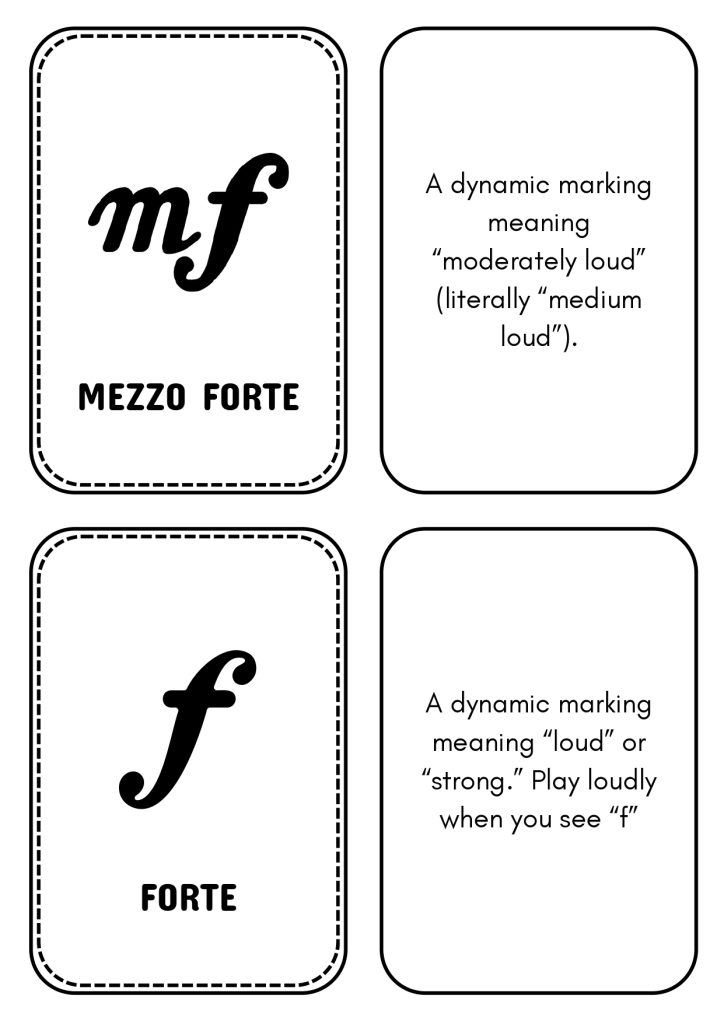
7. String Instruments Kids Recognize:
- Guitar appears in country music, rock songs, folk tunes, and around campfires. Six strings create everything from gentle strumming to energetic picking.
- Violin produces that sweet, singing tone that leads orchestras and adds emotion to movie soundtracks. Four strings played with a bow create sounds that can make people cry or dance.
- Cello sits between the player’s knees and creates rich, warm tones. Bigger than a violin, it produces those deep, chocolatey sounds that provide harmony in orchestras.
- Double bass stands taller than most elementary students and creates the deepest string sounds. These foundational notes hold up entire musical arrangements.
8. Wind Instruments With Personality:
- Saxophone curved brass body with a single reed creates that smooth, jazzy sound kids hear in everything from school bands to pop music.
- Trumpet bright, piercing sound cuts through entire orchestras. Three valves control pitch while the player’s lips create the buzzing that becomes beautiful music.
- French horn coiled brass tubing ends in a wide bell. This produces mellow, warm sounds that blend beautifully with other orchestra instruments.
- Trombone slide moves in and out to change pitches smoothly. Kids love watching trombonists slide between notes in ways other instruments can’t match.
- Flute silver tube played sideways creates light, airy sounds that float above other instruments like musical butterflies.
- Clarinet black wooden body with silver keys produces smooth, liquid tones across a huge range of pitches.
- Oboe double reed creates distinctive, penetrating sounds that can be heard clearly even in full orchestras.
- Piccolo tiny flute that sounds an octave higher creates the highest, most piercing sounds in the entire orchestra.
9. Rhythm and Percussion
- Maracas filled with beads or seeds create the backbone rhythms of Latin music and add texture to countless musical styles.
- Harp tall frame with strings plucked by fingers creates those magical, flowing sounds that add elegance to orchestral pieces.
- Tambourine shallow drum surrounded by metal jingles adds rhythmic excitement when shaken or struck.
- Xylophone wooden bars struck with mallets create bright, bell-like tones that cut through other instruments clearly.
- Drum stretched membrane struck by sticks or hands provides the rhythmic foundation that drives most popular music.
- Drum kit complete collection of drums and cymbals arranged for one player creates the rhythmic backing for rock, pop, and jazz.
- Piano keyboard with hammers that strike strings can play melody, harmony, and rhythm simultaneously.
- Keyboard electronic instrument that recreates hundreds of different instrument sounds in one compact package.

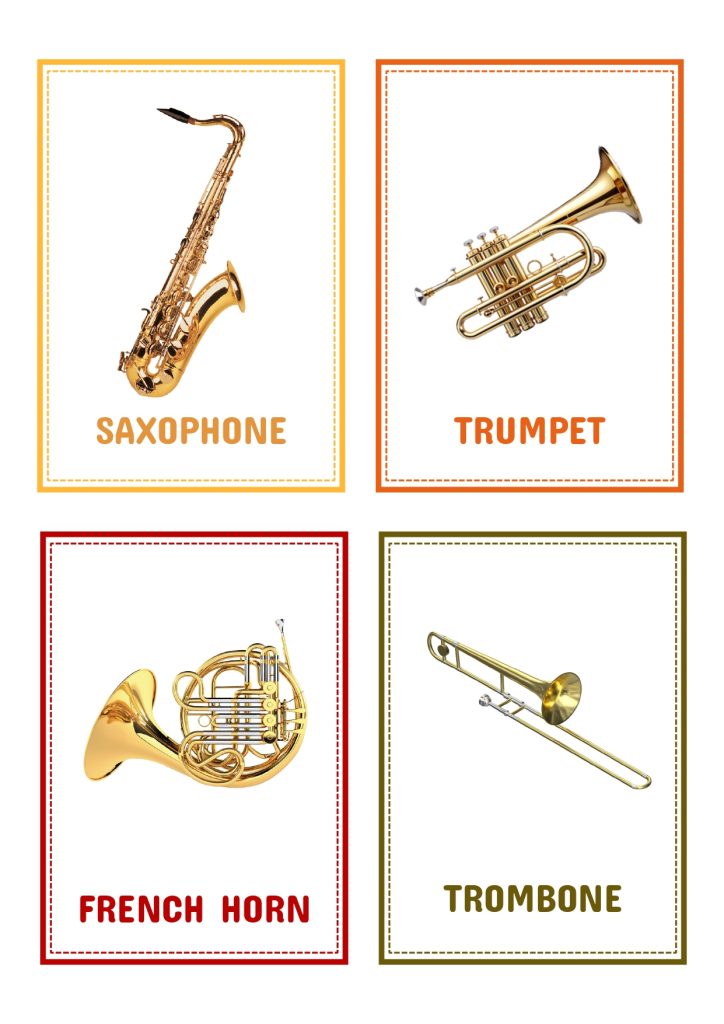
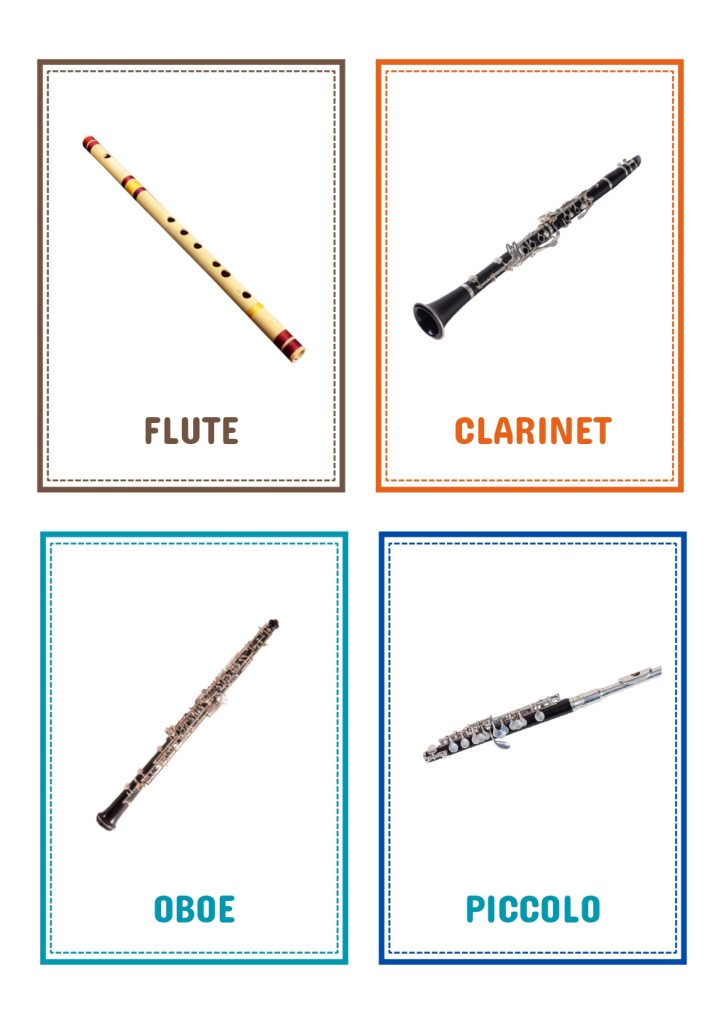

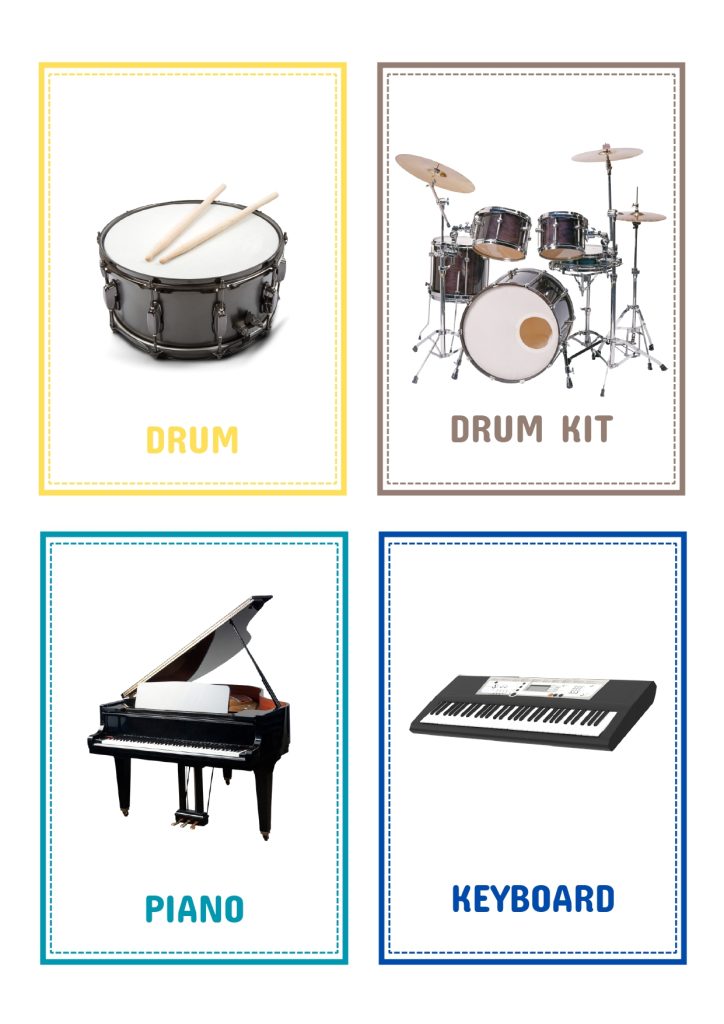
10. Musical Concepts Kids Feel Naturally
- Pitch: Describes how high or low sounds are. Every child understands the difference between tiny mouse squeaks and giant elephant rumbles.
- Rhythm: Patterns of long and short sounds create the backbone that makes music move forward in time.
- Tempo: Measures how fast or slow music moves. Kids naturally recognize the difference between energetic dance music and gentle lullabies.
- Dynamics: Describe volume levels from whisper-soft to shout-loud, giving music emotional expression beyond just correct notes.
- Melody: Sequence of notes that creates recognizable tunes. This is the part kids sing along with when they hear favorite songs.
- Harmony: Different notes played together create rich, full sounds that support melodies and add emotional depth.
- Tone color: unique sound quality that lets kids distinguish violin sounds from trumpet sounds even when they play identical notes.
- Beat: Steady pulse underneath music that makes people tap feet and nod heads automatically.
- Meter: Grouping of beats into regular patterns creates the underlying organization that makes rhythm predictable.
- Form: Overall structure of musical pieces. Kids understand verses and choruses in pop songs without needing technical explanations.
- Texture: Describes how many different sounds layer together, from solo voices to full orchestras.
- Articulation: Explains how notes connect or separate. Kids hear the difference between smooth, flowing music and sharp, detached sounds.
- Scale: Series of notes arranged in specific patterns create the foundation for melodies and determine whether music sounds happy or sad.
- Interval: Distance between two notes. Children naturally hear when notes sound close together versus far apart.
- Chord: Three or more notes played together create harmonic support that makes melodies sound complete and satisfying.
- Key: Main group of notes that songs center around, determining which notes work well together and the overall sound character.
- Phrase: Short musical sentences with natural beginnings and endings, similar to speech patterns kids already understand.
- Syncopation: Emphasizes unexpected beats, creating exciting rhythms that make music feel alive and unpredictable.
- Ornamentation: Decorative notes that add sparkle to basic melodies without changing their fundamental character.
- Motif: Short musical ideas that repeat throughout pieces, like the famous “da-da-da-DUM” opening of Beethoven’s Fifth Symphony.


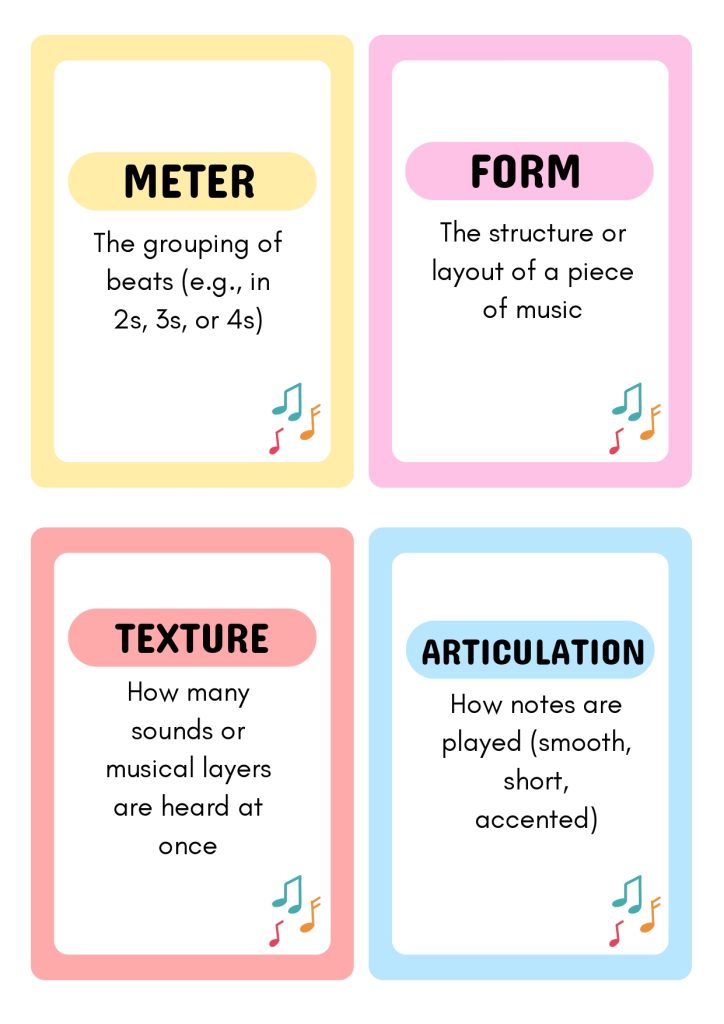
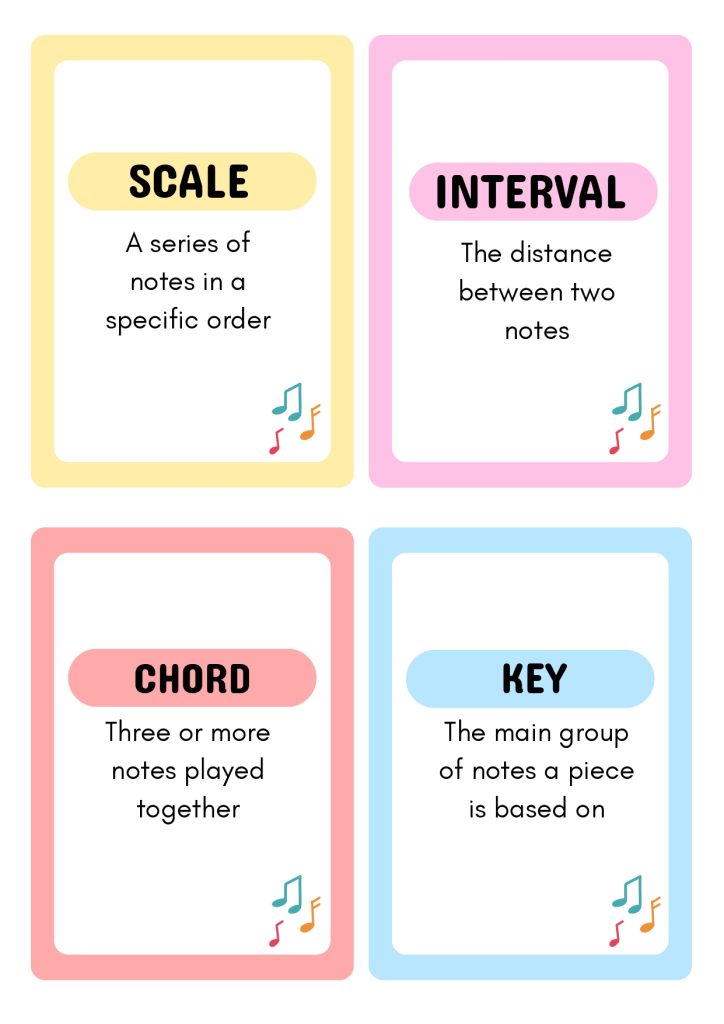
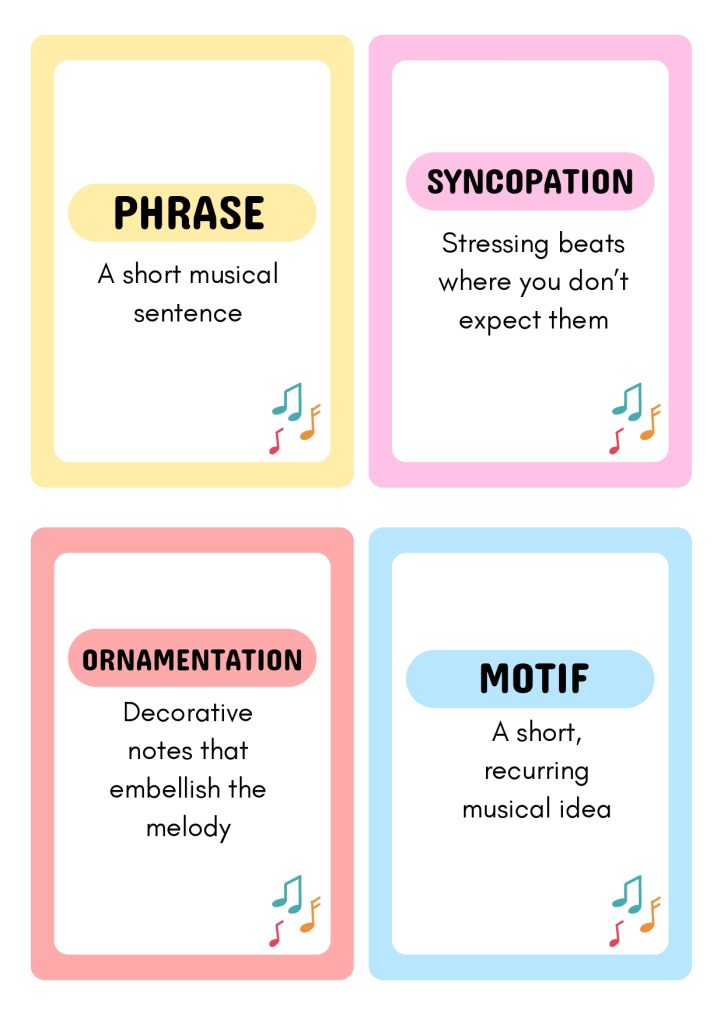
Games That Make Learning Stick
1. Musical Charades: Kids draw symbol cards and act them out without speaking. Forte brings out big, dramatic gestures. Piano creates tiny, gentle movements. Instruments get mimed with appropriate playing motions. This physical connection helps symbols stick in memory much better than just looking and memorizing.
2. Symbol Detective: Hide cards around the room with clues like “Find something that makes music last four beats” (whole note) or “Locate the symbol that means play loudly” (forte). Kids love scavenger hunts, and moving around while learning helps information stick better than sitting still at tables.
3. Rhythm Construction: Use note value cards to build rhythm patterns for clapping, tapping spoons, or playing simple instruments. Start with easy combinations like two quarter notes plus one half note. Build complexity gradually as confidence grows. This makes abstract symbols concrete and playable.
4. Instrument Sound Matching: Play short recordings of different instruments while kids race to find the matching cards. This develops listening skills alongside visual recognition, creating complete musical understanding instead of just memorizing pictures.
5. Volume Theater: Hold up dynamic cards while kids demonstrate different volume levels through movement and voice. Piano means tiptoeing and whispering. Forte means marching and projecting voices clearly. Physical demonstration makes abstract concepts memorable and entertaining.
6. Memory Matching: Spread cards face-down for traditional memory games. Match symbols with their meanings or pair related concepts like treble clef with high notes. Friendly competition keeps kids engaged while building recognition skills naturally.
7. Create Your Own Concert: Give kids collections of different cards to design their own musical performances. They choose instruments, arrange rhythms, select dynamics, and even conduct their imaginary orchestras. This transforms passive learning into active creativity.
Making Symbols Mean Something Real
Music symbols work like traffic signs for musicians. Just as stop signs tell drivers “come to a complete halt” and yield signs mean “slow down and check for other traffic,” music symbols provide essential information about what’s coming next and how to handle it properly.
The trick is connecting these symbols to experiences kids already have. Every child knows the difference between loud and soft sounds, fast and slow rhythms, high and low pitches. Music symbols simply attach names and visual markers to musical instincts children possess naturally from birth.
Regular practice with these flashcards creates the foundation for reading any piece of sheet music. Kids who recognize note values automatically understand rhythmic patterns. Children who know dynamic markings bring life and expression to their playing instead of just hitting correct notes mechanically like robots.
These symbols also develop pattern recognition skills that transfer to reading, mathematics, and problem-solving. Music notation combines logical thinking with creative expression, engaging both sides of the brain simultaneously in ways that strengthen overall learning ability.
Building Musical Literacy for Life
Understanding these music symbols opens doors to playing any instrument, joining school bands and orchestras, and eventually grasping advanced music theory concepts. Children who master basic music notation often discover they can pick up new instruments more easily because they already speak the universal language of written music.
This musical foundation creates confidence that lasts throughout life. Adults who learned to read music as children often return to musical hobbies later, even after years away from instruments. The symbols become like riding a bicycle – once learned properly, they’re never completely forgotten.
Simple Printing Instructions: Download Music Symbols Flashcards. Open the PDF and select standard print settings. Use portrait orientation with “fit to page” for correct sizing. Color printing showcases the different instruments and symbols more clearly, but black and white works perfectly for learning purposes.
If you are printing flashcards for young musicians, print on cardstock or regular paper with lamination. This protects against spills and constant handling while maintaining clear symbol visibility. Cut along the provided lines and your music symbol cards are ready for years of musical discovery. You can also check out wild animals flashcards to make learning more interesting for your kids.
